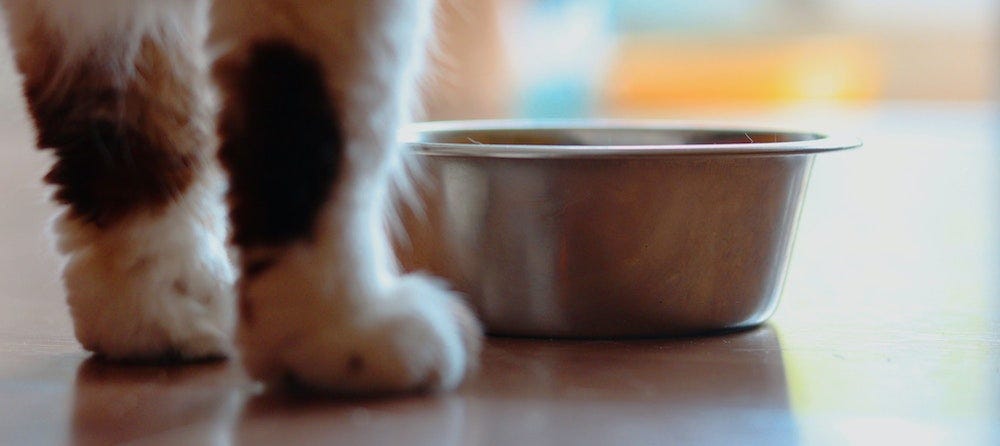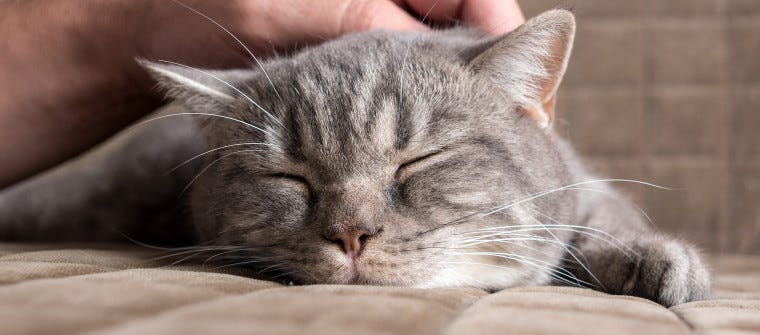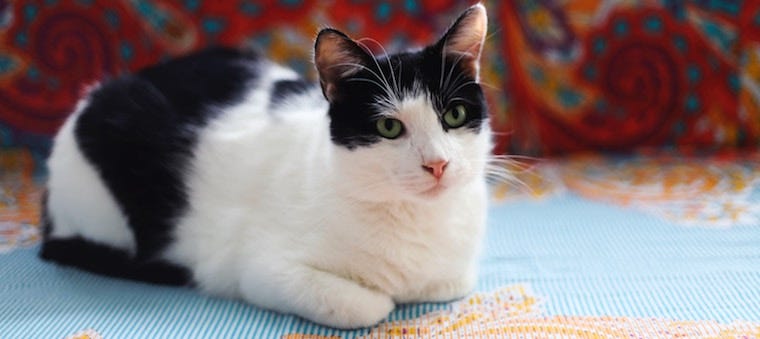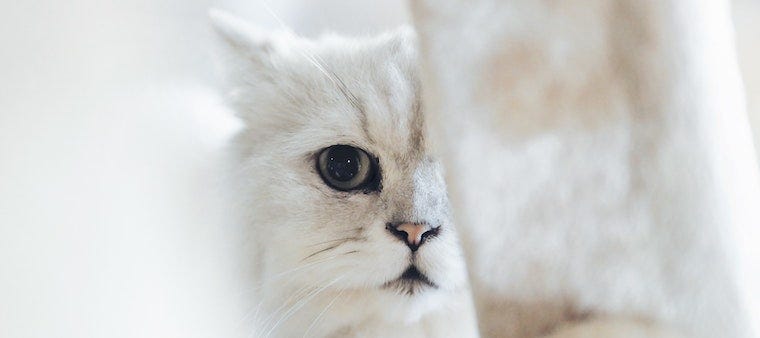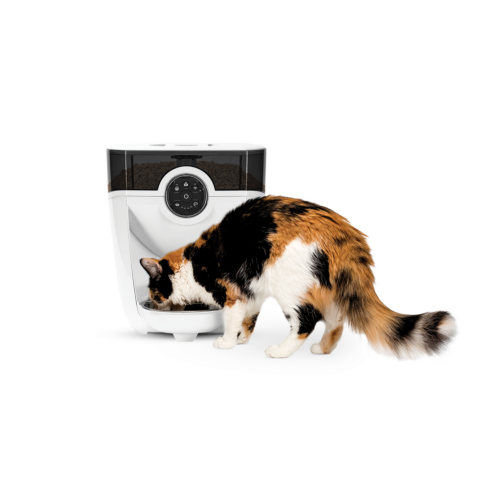If you’re the type of cat parent who picks up a new kind of cat food when your cat just ran out, this blog is a must-read. Why? Because cats hate sudden change… when it comes to anything in life. Find out why something as simple as changing a bag or flavor of cat food can have serious health effects on your cat—specifically, hepatic lipidosis in cats, or “fatty liver.”
How long can a cat go without eating?
So, why should you think twice about springing a new kind of food on your cat? Because if it’s not the same exact brand and flavor, your cat may not eat it right away. Cats aren’t like dogs, who can go for several days to weeks without eating. If cats don’t eat for more than 3-5 days, they can develop inappropriate fat infiltration into the liver—what we call hepatic lipidosis or “fatty liver.” Most adult cats average around 200-220 calories/day, so even skipping a few meals can result in insufficient calories and secondary liver changes.
Why do cats develop hepatic lipidosis?
If your cat was just diagnosed with hepatic lipidosis, fear not! It is treatable, but it requires an extensive (read expensive!) work-up and a lot of treatment at your veterinarian and at home. When in doubt, you always want to avoid this medical problem in your cat.
As an emergency critical care veterinary specialist, I see hepatic lipidosis in cats for several common reasons:
- When you change your cat’s diet too quickly. Again, cats hate sudden change, so cats never want to go “cold turkey” or have a sudden change in diet. Cats need slow acclimatization over several days to weeks when it comes to diet change.
- When you introduce a new 2-legged (newborn child) or 4-legged (dogs, cats) member into the household. This can be very stressful to your cat’s normal mojo, and often will cause a lot of environmental stress that makes your cat start to hide and stop eating.
- When you move or change your living situation due to environmental stress—like getting a new roommate or making a cross-country road trip to move.
- When you have more stress in your life—like having your family visit for the holidays, changes in jobs, home construction, etc.
- From underlying medication problems. Illnesses like pancreatitis, diabetes mellitus, or underlying cancer can cause your cat to stop eating, adding secondary complications to their medical problems.
Breeds predisposed to hepatic lipidosis
While there are no specific breeds of cats that are predisposed to hepatic lipidosis, cats that are overweight or obese are at highest risk. So, if your cat is over 11 pounds and has a pot belly that swings when he walks, or where the pot belly almost touches the ground, I’m talking to you. (If you’re not sure, you can compare your cat here on this Purina Body Condition Score.)
What are the signs that my cat has hepatic lipidosis?
Clinical signs of hepatic lipidosis in cats can include:
- Decreased appetite
- Complete anorexia
- Acting weak or lethargic
- Lying in unusual places or even hiding
- Yellow coloring of the skin (called jaundice), often seen around the eye tips, gums, whites of the eyes, and skin
- Drooling (a sign of nausea)
- Vomiting
- Dehydration
- Holding the neck down more than normal (due to electrolyte abnormalities)
- Losing weight or noticing muscle wasting (over the back)
- Smaller fecal or urine clumps in the litter box
- Walking drunk
- Collapse
In severe cases of hepatic lipidosis in cats, clinical signs include:
- Dark or black tarry stool
- Bruising on the skin (due to abnormal clotting)
- Seizures or acting neurologically abnormal (from the liver poisons such as ammonia building up in the body)
- Death
How do veterinarians diagnose hepatic lipidosis in cats?
Your veterinarian will need to get a thorough history (getting information about environmental changes, changes in diet, recent stress, etc.), do a thorough physical examination, and look at blood work to determine if your cat has hepatic lipidosis. Specific blood work that should be done includes a complete blood count and biochemistry panel. These will look at the white and red blood cells, kidney and liver function, electrolytes, and protein levels in your cat. With hepatic lipidosis, the blood work typically shows elevated liver values (specific tests called the ALT, AST, ALK PHOS, TBILI, GGT), electrolyte abnormalities, and evidence of jaundice (which is an elevated bilirubin or “TBILI” value). These are my first clues that your cat may have something serious going on in the liver.
Additional blood tests that may need to be done include a feline leukemia/FIV test, a clotting test (as liver problems can affect clotting), and even an ammonia level (especially if your cat is showing neurologic signs such as walking drunk or seizuring). Next, an ultrasound of the abdomen is important—especially focusing on the liver, gallbladder, bile ducts, and pancreas. An aspirate of the liver is often necessary to help rule out other causes of increased liver values and jaundice in cats, such as cholangiohepatitis, pancreatitis, gallbladder stones, cancer (specifically lymphosarcoma), inflammatory bowel disease, or even certain poisons (like acetaminophen/Tylenol poisoning in cats).
What is the treatment for cats diagnosed with hepatic lipidosis?
Thankfully, cats with hepatic lipidosis can recover well with treatment, but this often requires intensive 24/7 hospitalization and care. However, hepatic lipidosis can cause liver failure—and even death—without aggressive treatment by your veterinarian.
Treatment for hepatic lipidosis in cats includes:
- Intravenous (IV) fluids to help treat dehydration
- Anti-vomiting medication (e.g., maropitant, ondansetron, etc.)
- Appetite stimulants (e.g., mirtazapine)
- Antacids
- Appropriate nutrition and placement of a temporary feeding tube (such as a nasoesophageal, nasogastric, or esophagostomy tube) to provide adequate calories (this may be necessary for several weeks, and will include you doing these feedings at home)*
- A temporary funnel hat around your cat’s neck to prevent your cat from pulling out the temporary feeding tube
- Antibiotics (in case there is underlying cholangiohepatitis also)
- Possible pain medications (e.g., buprenorphine)
- Low dose vitamin K1 to help fix clotting problems (if abnormal on blood work)
- Potential plasma transfusions (if severe clotting problems are noted)
- Frequent blood work monitoring and supportive care (e.g., blood pressure monitoring)
Once your cat is more hydrated and no longer showing signs of nausea, vomiting, or pain, and if the blood work and jaundice is improving, your cat may be able to go home with supportive care. This may include appetite stimulants (which also comes as a transdermal form, so it’s easier to give to cats) and learning how to feed your cat through the temporary feeding tube at home. While this initially seems intimidating, once you and your cat get used to it, it’s easy to do. Tube-feeding a cat at home typically requires you giving approximately 60 milliliters (4 TABLEspoons) of a veterinary prescription liquid diet every 6 hours until your cat is eating normally at home again and the liver values return to normal.
* Please note that I never advocate force feeding or syringe feeding a cat through the mouth. You can’t safely get enough nutrition into your cat and your cat really resents this, affecting your cat’s bond to you and making your cat run away from you!
Prognosis
Thankfully, the prognosis for hepatic lipidosis in cats is fair to excellent with rapid diagnosis, treatment, and nutrition. 85% of cats will recover well, but keep in mind that your cat often will need that temporary feeding tube for several weeks. Thankfully, cats typically recover without any long-term side effects.
Preventing hepatic lipidosis in cats
While the prognosis for hepatic lipidosis in cats is good, this disease is expensive to treat and “high maintenance” to treat at home. It also puts your cat through a lot, since your cat may need a temporary feeding tube.
Do everything slowly
There are things you can do to hopefully minimize the risk of your cat developing hepatic lipidosis. When it comes to cats, do everything slowly—that way your cat has plenty of time to acclimate to any new changes. Make sure to slowly wean in new food as you approach the bottom third of the bag of cat food. If you’re introducing new pets or kids to the household, consult with your veterinarian, a veterinary behaviorist, or a qualified trainer if needed. Try to minimize the amount of stress in your cat’s life, and talk to your veterinarian about anti-anxiety medication if needed to help. There are both holistic medications (like Feliway) and prescription medications (like trazodone).
Monitor how much your cat is eating
Most importantly, make sure to monitor how much your cat is eating—this is especially important if you just leave a big bowl of food out. An easy way to monitor how much your cat is eating is with a WiFi-enabled, automatic pet feeder like Feeder-Robot. With this smart pet feeder, you can compare your cat’s weekly and monthly feeding stats for high-level insights.
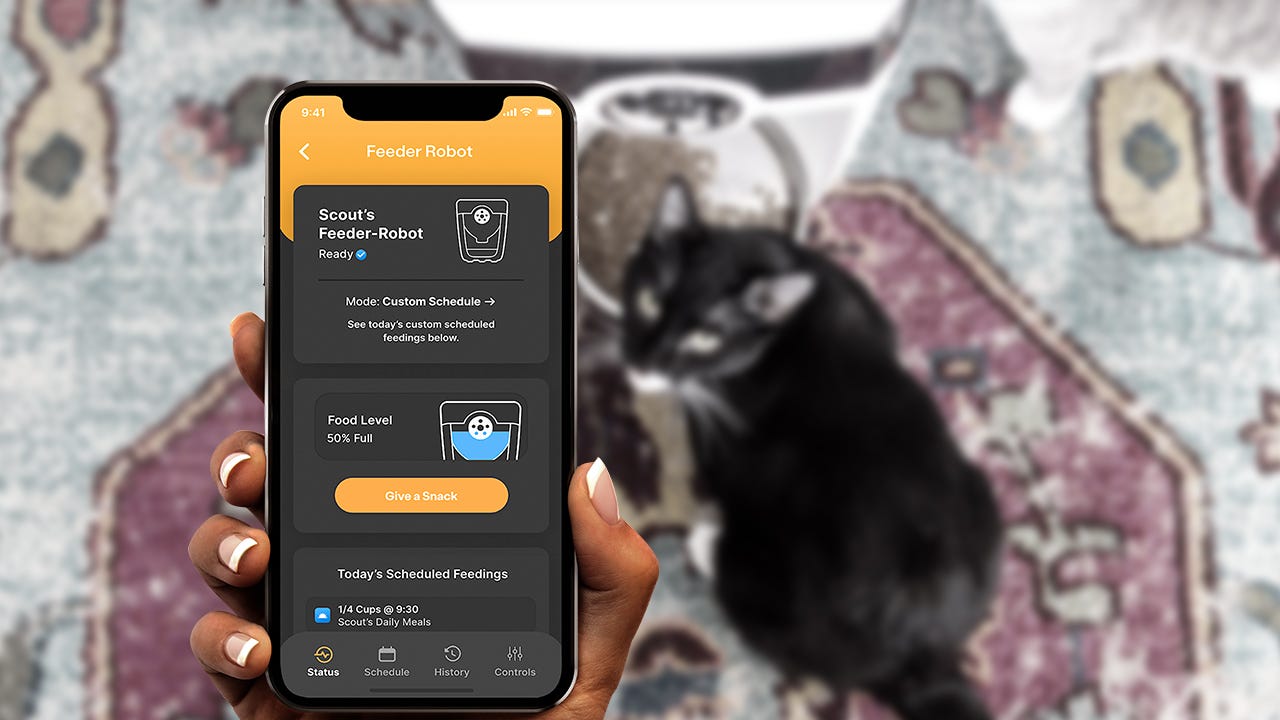
Lastly, if you notice that your cat hasn’t eaten for several days, get to a veterinarian immediately!
When in doubt, call to schedule an appointment on the first day of not eating—that way you have the appointment ready if needed. If the appointment is several days away, you can always cancel it (typically 24 hours in advance). Remember, it’s not normal for a cat to stop eating, and oftentimes there’s something going on. The sooner you recognize the problem, the sooner you get to a veterinarian, the sooner they can diagnose it, and often, the less expensive—and less dangerous—it can be to your cat!
If cats don’t eat for more than 3-5 days, they can develop inappropriate fat infiltration into the liver—what we call hepatic lipidosis or “fatty liver.”
Reference
- Center SA. Hepatic lipidosis. In Blackwell’s Five-Minute Veterinary Consult: Canine & Feline. Eds. Tilley LP, Smith FWK. 2007, 4th ed. Blackwell Publishing, Ames, Iowa. pp. 598-599.
Cover photo by Marco Giuseppe on Unsplash

